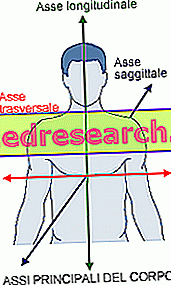Anatomical axes: they can be compared to skewers that cross the body. These imaginary lines are used to trace the axis on which the rotational movements take place. A bit like what happens to the hinges of a door.
The door moves in a plane around an axis. The plane (the door) is determined by the orientation of the pin in the hinge (axis).
Main axes of the human body
- Longitudinal axis (vertical). It is perpendicular to the support base, when the body is in an upright position.
- Transverse axis (horizontal): it is directed from left to right and is perpendicular to the longitudinal axis.
- Sagittal axis (antero-posterior): it is directed from the posterior surface to the anterior surface of the body. This axis is perpendicular to the other two axes.

Anatomical Plans
The anatomical planes are imaginary lines drawn through the body. These lines allow you to objectively describe the movements and positions of the body.
There are four anatomical planes, although only three are often considered.
- Median plane : it is an imaginary vertical plane that passes through the center of the body (through the longitudinal and sagittal axes), dividing it into two equal (right and left) halves or antimers. The sagittal plane is an imaginary vertical plane parallel to the median plane that does not necessarily pass through the center. Often these two planes are considered as a single plane called median sagittal.
- Frontal or coronal plane: it is a vertical plane parallel to the front and perpendicular to the median plane (it passes through the transverse and longitudinal axes). It divides the body in front and back.
- Horizontal or transverse plane: it is a plane that divides the body into two upper and lower halves. In an upright position it is horizontal. It is located perpendicular to the median and frontal planes and passes through the transverse and sagittal axes.

Anatomical Position

The anatomical position is a position used as a reference point to establish the relationships between the different parts of the body.
The anatomical terms such as anterior and posterior, medial and lateral, abduction and adduction are always referred to the anatomical position.
A person who is in the anatomical position:
He is standing upright
with the head erect, gaze and palms of the hands facing forward, arms at the sides and fingers extended, feet forward and perpendicular to the body.
Directions of Movement
| FLEXION: movement in which one segment tends to form an increasingly acute angle with another |  |
| EXTENSION: movement for which a segment tends to place itself on the same level as the other |  |
| ABDUCTION: away from the medial plane of the body |  |
| ADDUCTION: approach to the medial plane of the body |  |
| ROTATION: movement performed by a segment around its main axis |  |
| CIRCONDUCTION: movement for which a segment describes a cone with apex corresponding to the articular head |  |
Anatomical index
| Upper limb | Lower limb | Trunk | Abdomen | Articles |



